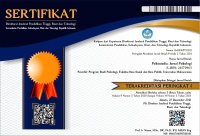Pengembangan dan Validasi Skala Keberfungsian Keluarga Menggunakan Analisis Faktor Konfirmatori
Abstract
Family functioning is a pivotal factor influencing child’s problems including mental, behavioral, and developmental disorder. This study aimed to assemble and validate family functioning scale using confirmatory factor analysis. The research was done on 134 late adolescences, age ranges were between 18-22 y.o. Family functioning scale was developed from the process model of family functioning which has seven components i.e., task accomplishment, role performance, communication, affective expression, affective involvement, control, and value and norm. The result shows that all components have significant factor loadings, and the scale is reliable. However, the data has shown that the model is not fit enough indicated by underperformed CFI. TLI, and RMSEA. Suggestions for future development were discussed.
Keberfungsian keluarga merupakan faktor penting dalam mengatasi permasalahan-permasalahan anak seperti gangguan mental, perilaku, dan perkembangan. Penelitian ini bertujuan untuk menyusun dan memvalidasi skala keberfungsian keluarga menggunakan analisis faktor konfirmatori. Penelitian dilakukan terhadap 134 remaja akhir dengan rentang usia 18-22 tahun. Instrumen skala keberfungsian keluarga dikembangkan berdasarkan teori proses keberfungsian keluarga yang memiliki tujuh komponen yaitu pencapaian tugas, kinerja peran, komunikasi, ekspresi afektif, keterlibatan afektif, kontrol, dan nilai serta norma. Hasil penelitian menunjukkan bahwa semua komponen memiliki Factor Loading yang signifikan dan skala bersifat sangat reliabel. Hanya saja, skala belum menunjukkan model fit yang cukup karena nilai CFI, TLI, dan RMSEA yang belum mencapai standar. Saran untuk perkembangan penelitian ini telah didiskusikan.
Keywords
Full Text:
FULL TEXTReferences
arons, G. A., Mcdonald, E. J., Connelly, C. D., & Newton, R. R. (2007). Assessment of Family Functioning in Caucasian and Hispanic Americans: Reliability, Validity, and Factor Structure of the Family Assessment Device. Family Process, 46(4), 557–569. https://doi.org/10.1111/j.1545-5300.2007.00232.x
Chapman, L. K., & Woodruff-Borden, J. (2009). The impact of family functioning on anxiety symptoms in African American and European American young adults. Personality and Individual Differences, 47(6), 583–589. https://doi.org/10.1016/j.paid.2009.05.012
Curt LaFrance Jr., W., Alosco, M. L., Davis, J. D., Tremont, G., Ryan, C. E., Keitner, G. I., Miller, I. W., & Blum, A. S. (2011). Impact of family functioning on quality of life in patients with psychogenic nonepileptic seizures versus epilepsy: Family Functioning, Quality of Life, and Seizures. Epilepsia, no-no. https://doi.org/10.1111/j.1528-1167.2010.02765.x
Dahinten, V. S., Shapka, J. D., & Willms, J. D. (2007). Adolescent Children of Adolescent Mothers: The Impact of Family Functioning on Trajectories of Development. Journal of Youth and Adolescence, 36(2), 195–212. https://doi.org/10.1007/s10964-006-9140-8
Epstein, N. B., Bishop, D. S., & Levin, S. (1978). The McMaster Model of Family Functioning. Journal of Marital and Family Therapy, 4(4), 19–31. https://doi.org/10.1111/j.1752-0606.1978.tb00537.x
Etikan, I. (2017). Sampling and Sampling Methods. Biometrics & Biostatistics International Journal, 5(6). https://doi.org/10.15406/bbij.2017.05.00149
Gorman-Smith, D., Tolan, P. H., Zelli, A., & Huesmann, L. R. (1996). The relation of family functioning to violence among inner-city minority youths. Journal of Family Psychology, 10(2), 115–129. https://doi.org/10.1037/0893-3200.10.2.115
Holtom-Viesel, A., & Allan, S. (2014). A systematic review of the literature on family functioning across all eating disorder diagnoses in comparison to control families. Clinical Psychology Review, 34(1), 29–43. https://doi.org/10.1016/j.cpr.2013.10.005
Hox, J. J. (2021). Confirmatory Factor Analysis. In J. C. Barnes & D. R. Forde (Eds.), The Encyclopedia of Research Methods in Criminology and Criminal Justice (1st ed., pp. 830–832). Wiley. https://doi.org/10.1002/9781119111931.ch158
Minuchin, S., Rosman, B. L., & Baker, L. (1978). Psychosomatic families: Anorexia nervosa in context. Harvard University Press.
Muthén, L. K., & Muthén, B. O. (2002). How to Use a Monte Carlo Study to Decide on Sample Size and Determine Power. Structural Equation Modeling: A Multidisciplinary Journal, 9(4), 599–620. https://doi.org/10.1207/S15328007SEM0904_8
Myers, N. D., Ahn, S., & Jin, Y. (2011). Sample Size and Power Estimates for a Confirmatory Factor Analytic Model in Exercise and Sport: A Monte Carlo Approach. Research Quarterly for Exercise and Sport, 82(3), 412–423. https://doi.org/10.1080/02701367.2011.10599773
Patterson, J. M., McCubbin, H. I., & Warwick, W. J. (1990). The impact of family functioning on health changes in children with cystic fibrosis. Social Science & Medicine, 31(2), 159–164. https://doi.org/10.1016/0277-9536(90)90057-Y
Saifuddin, A. (2020). Penyusunan Skala Psikologi. Pranada Media.
Schmitt, T. A. (2011). Current Methodological Considerations in Exploratory and Confirmatory Factor Analysis. Journal of Psychoeducational Assessment, 29(4), 304–321. https://doi.org/10.1177/0734282911406653
Shek, D. T. L., & Ma, C. M. S. (2010). The Chinese Family Assessment Instrument (C-FAI): Hierarchical Confirmatory Factor Analyses and Factorial Invariance. Research on Social Work Practice, 20(1), 112–123. https://doi.org/10.1177/1049731509355145
Skinner, H. A., Steinhauer, P. D., & Santa-Barbara, J. (2011). Family Assessment Measure III [Data set]. American Psychological Association. https://doi.org/10.1037/t02209-000
Skinner, H., Steinhauer, P., & Sitarenios, G. (2000). Family Assessment Measure (FAM) and Process Model of Family Functioning. Journal of Family Therapy, 22(2), 190–210. https://doi.org/10.1111/1467-6427.00146
Stoutjesdijk, R., Scholte, E. M., & Swaab, H. (2016). Impact of Family Functioning on Classroom Problem Behavior of Children With Emotional and Behavioral Disorders in Special Education. Journal of Emotional and Behavioral Disorders, 24(4), 199–210. https://doi.org/10.1177/1063426615587262
Wang, Q., & Zhou, T. (2015). The Impact of Family Functioning and Mental Health Condition on the Child’s Behavioral Problems. Social Behavior and Personality: An International Journal, 43(7), 1135–1145. https://doi.org/10.2224/sbp.2015.43.7.1135
Widhiarso, W. (2016). Peranan Butir Unfavorabel Dalam Menghasilkan Dimensi Baru Dalam Pengukuran Psikologi. Jurnal Psikologi Perseptual, 1(1). https://doi.org/10.24176/perseptual.v1i1.1078
DOI: http://dx.doi.org/10.30872/psikostudia.v11i4.8264
Refbacks
- There are currently no refbacks.
Copyright (c) 2022 Psikostudia : Jurnal Psikologi

This work is licensed under a Creative Commons Attribution-ShareAlike 4.0 International License.
Psikostudia: Jurnal Psikologi is indexed by :
PSIKOSTUDIA: Jurnal Psikologi Published by Faculty of Social and Political Siences, University of Mulawarman, Samarinda, East Kalimantan and This work is licensed under a Creative Commons Attribution-ShareAlike 4.0 International License.
_________________________________________
PSIKOSTUDIA: Jurnal Psikologi
Department of Psychology
Faculty of Social and Political Siences, University of Mulawarman
Jl. Muara Muntai Kampus Gn. Kelua Samarinda 75411
Phone: +62 813 35350368
E-Mail: psikostudia@fisip.unmul.ac.id




















